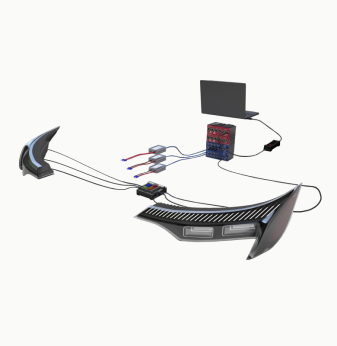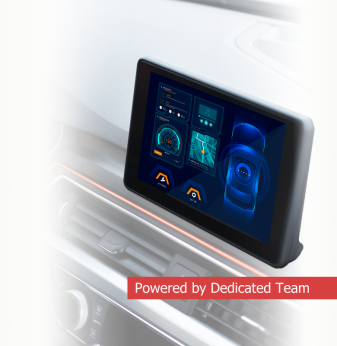Technology on Guard: How Promwad Helps Combat Driver Fatigue

Driver fatigue isn't just an unpleasant sensation; it's a serious safety hazard. Statistics indicate that one in five (20%) road traffic incidents is caused by driver fatigue. At Promwad, we understand the importance of implementing innovative technologies to address this issue. Today, we'll discuss how modern Driver Fatigue Detection Systems (DFDS) are changing the automotive industry and how Promwad contributes to this process.
Fatigue: A Hidden Threat on the Road
Fatigue reduces vigilance by 30%, slows reaction time by 20%, and impairs decision-making by 25%. A fatigued driver may fail to notice a dangerous situation or react in time. This is especially dangerous at high speeds, where even fractions of a second can make a critical difference. For example, at a speed of 100 km/h, a vehicle travels 28 meters per second.
How Modern DFDS Work
Modern DFDS use a combination of various technologies to assess the driver's condition:
- Driver Behavior Analysis:
- Systems track steering wheel movements (over 100 parameters per second), pedal usage, and the vehicle's overall trajectory.
- Erratic driving, sharp turns (over 15 degrees per second), and lane departures (over 0.5 meters) can indicate fatigue.
- Driver State Monitoring:
- Cameras installed in the vehicle's interior track eye movements (up to 60 frames per second), blinking (over 12 times per minute), yawning (over 3 times per 5 minutes), and head position.
- Drowsiness is characterized by frequent blinking, closed eyes (over 2 seconds), and head nods (over 30 degrees).
- Physiological Sensors:
- Some systems use sensors to measure heart rate (from 40 to 120 beats per minute), breathing rate (from 12 to 20 breaths per minute), and other physiological parameters.
- Changes in these parameters by 15-20% can indicate fatigue.
- Artificial Intelligence (AI):
- AI plays a key role in processing data and identifying signs of fatigue.
- Machine learning algorithms analyze driver behavior and physiological parameters to assess fatigue levels with up to 95% accuracy.
Trends and Innovations in DFDS
- Integration with Navigation Systems:
- DFDS can recommend rest stops every 2 hours or after 200 km of travel, based on the driver's fatigue level and data on nearby rest areas.
- This allows drivers to plan their trips based on their condition.
- Personalized Alerts:
- Systems can tailor alerts to individual driver characteristics, for example, by issuing an audible signal with a frequency of 440 Hz.
- For example, drivers prone to rapid fatigue may receive more frequent alerts (every 30 minutes).
- Use of Wearable Devices:
- Smartwatches and other wearables can provide additional data on the driver's physiological state, such as tracking heart rate variability (HRV) with up to 98% accuracy.
- This allows for more accurate assessment of fatigue levels.
- Cloud Technologies and Big Data Analytics:
- Cloud platforms can collect and analyze data on the state of millions of drivers in real-time.
- This allows for the identification of general trends and the improvement of fatigue detection algorithms by 25-30%.
- Also gives a possibility to collect large amounts of data, for further neural network learning, that increases the accuracy of systems work by 15% in average.
Table 1: Technologies and Their Contribution to Driver Fatigue Detection
| Technology | Operation Principle | Advantages | Disadvantages |
| Driver Behavior Analysis | Tracking steering wheel movements, pedals, trajectory | Simplicity of implementation, no additional sensors required | May give false positives in 10-15% of cases in complex road conditions |
| Driver State Monitoring | Analysis of eye movements, blinking, yawning, head position | High accuracy (up to 90%), early detection of fatigue signs | Requires installation of cameras in the vehicle interior, increasing costs by 5-10% |
| Physiological Sensors | Measurement of heart rate, breathing rate, ECG | Objective assessment of the driver's condition with up to 95% accuracy | Requires installation of additional sensors, increasing costs by 3-5% |
| Artificial Intelligence | Data analysis using machine learning algorithms | High accuracy, ability to detect complex dependencies | Requires large amounts of data for training |
How Promwad Helps in the Development of DFDS
Promwad has extensive experience in the development of automotive electronics and software. We offer the following services:
- Embedded Software Development: We develop algorithms for analyzing driver behavior, monitoring state, and processing data from physiological sensors.
- Development of Machine Learning Systems: We create machine learning algorithms to identify signs of fatigue based on large volumes of data.

- Integration with Various Sensors and Systems: We integrate DFDS with other vehicle systems, such as navigation systems and collision warning systems.
- Mobile Application Development: Development of mobile applications, to get information about the driver state in real time.
Table 2: Promwad's Contribution to DFDS Development
| Direction | Description | Project Examples |
| Embedded Software Development | Creating algorithms for analyzing driver behavior and monitoring state | Algorithms for analyzing steering wheel and pedal movements, algorithms for tracking eye movements and head position |
| Development of Machine Learning Systems | Creating algorithms to identify signs of fatigue based on large volumes of data | Algorithms for analyzing physiological data, algorithms for analyzing video streams from cameras |
| Integration with Sensors and Systems | Integrating DFDS with other vehicle systems | Integration with navigation systems, integration with collision warning systems |
| Mobile Application Development | Creating mobile applications for monitoring driver state | Mobile application for tracking fatigue levels, mobile application for receiving rest recommendations |
Real-Life Examples
- Mercedes-Benz Attention Assist: This system analyzes steering wheel movements and other parameters to detect signs of fatigue.
- Volvo Driver Alert System: This system uses a camera to track the driver's head and eye position.
- Systems in Tesla Vehicles: Tesla vehicles are equipped with internal cameras to monitor the driver's condition.
The Future of DFDS
In the future, DFDS will become even more advanced and integrated into the vehicle's overall safety system. It is expected that they will be able not only to detect fatigue but also to take active measures to prevent accidents. For example, systems will be able to automatically reduce the vehicle's speed by 30-40% or even stop it within 5-10 seconds if a critical level of driver fatigue is detected.
Conclusion
Driver fatigue detection technologies play an important role in improving road safety. With the development of AI and other technologies, these systems will become even more effective and reliable, helping to save lives and prevent road accidents. Promwad is proud to contribute to the development of these technologies, making roads safer for everyone.
Links:
- For more information on ADAS systems: ADAS Systems Market Outlook - MarketsandMarkets
- To learn more about AI in automotive: Artificial Intelligence (AI) in Automotive Industry - Research and Markets
- To discover Promwad's Automotive Engineering Services: Promwad Automotive Engineering
- For more information about Driver fatigue: Driver Fatigue and Drowsiness: State of Knowledge Review



































